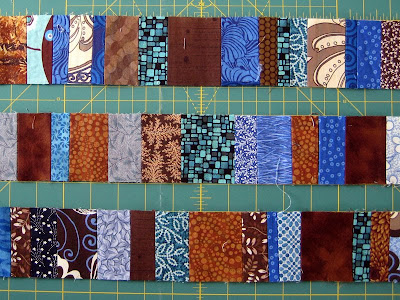More than a year ago I started collecting blue and brown fabrics for a quilt for my bed based on the Marquee pattern from
The Modern Quilt Workshop
. I set the project aside for a while, then restarted with an expanded scope when I decided to make a second quilt for Hamish's living room. Then came another project, and now I'm finally finishing my blanket. I started stippling today.
It's been a fun and relatively easy project. The all-cotton fabrics range from pricey quilt-shop purchases to bargain-bin finds. Most of the blues are royal, with a few aquas, grays and other outliers thrown in.
I started by cutting my browns and blues in random-width strips, selvage to selvage. When I grouped bunches of 10 to 15 strips to make panels, I found that the color balance was too heavily weighted towards brown. I liked the balance after I threw some more blue strips into the mix and sewed 17 or 18 panels, each about 24" x 42".
With the addition of the the extra blue pieces I ended up with several bonus strip panels, most of which I've been able to put to use.
The next step was to cut the panels into even strips perpendicular to the color bands. This resulted in the one tricky part of the project. The rotary cutter left the seam edges raw. Because at least one edge of each strip remained raw over most of the course of the project, the blocks required careful handling to prevent unraveling.
I cut my background fabric into 50 small squares and 49 larger squares. Although the pattern recommends solid or low-contrast prints for the background fabric I couldn't resist "All Cotton" from Alexander Henry. I pieced the strips to two oposite sides of each small square, pressed the seams flat and squared the edges on the rotary mat, then pieced, pressed and squared the remaining two edges of each small square. I arranged the resulting 99 squares, alternating solid and marquee and avoiding sequence repetition in neighboring blocks.
Once I had completed the blocks, assembling the quilt top went quickly and it was a relief to finish the pieced edges of the marquee blocks. The quilt sandwich took 396 safety pins. It also took over my entire living room. Note the sofa on end in the corner, looming over my helpful son.
I like the effect of the diagonal bias strips, though I wonder how durable the pieced binding will be, and I'm curious to hear about other quilters' experiences.
I'll post pictures of the finished quilt as soon as I can.



















